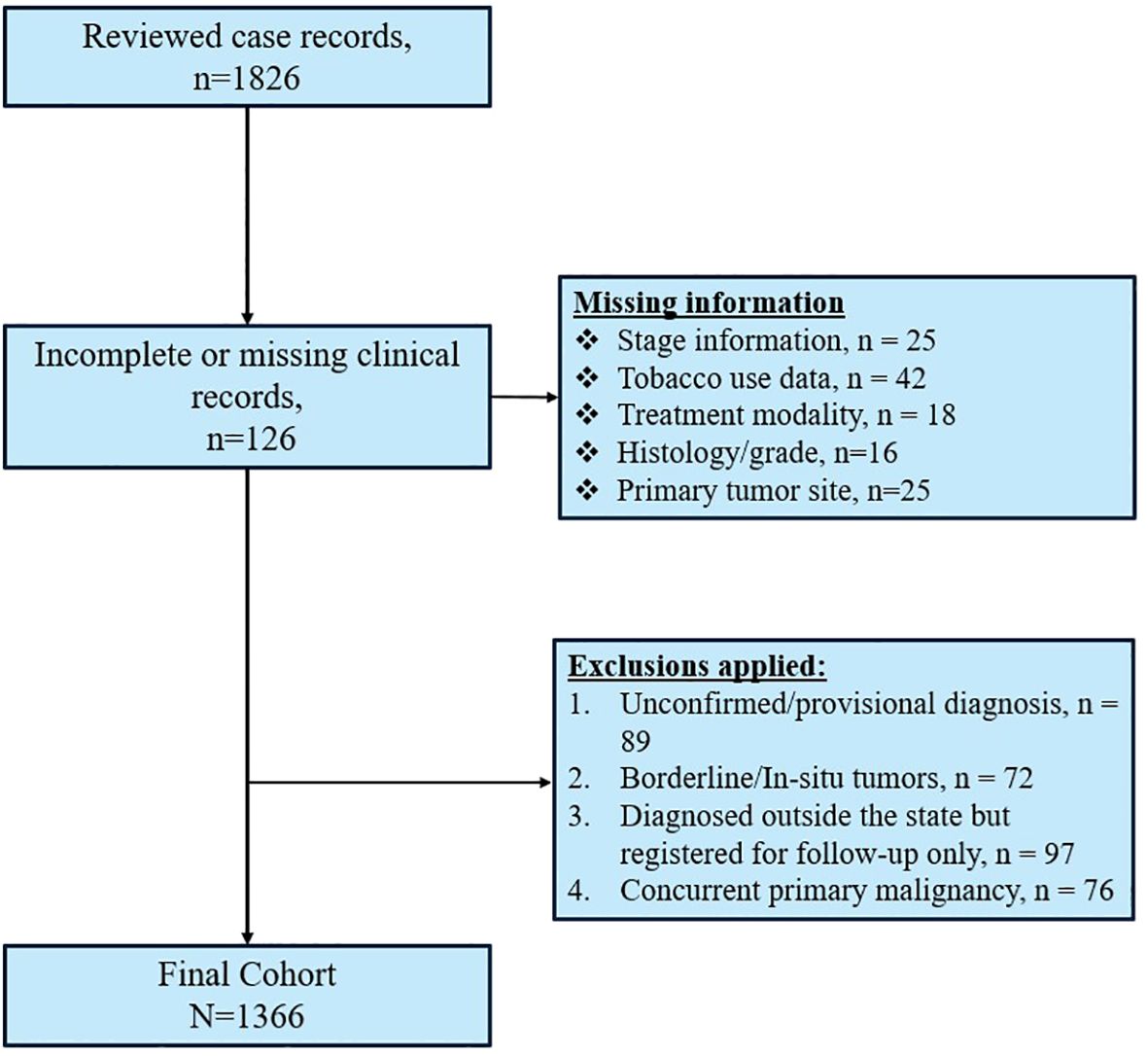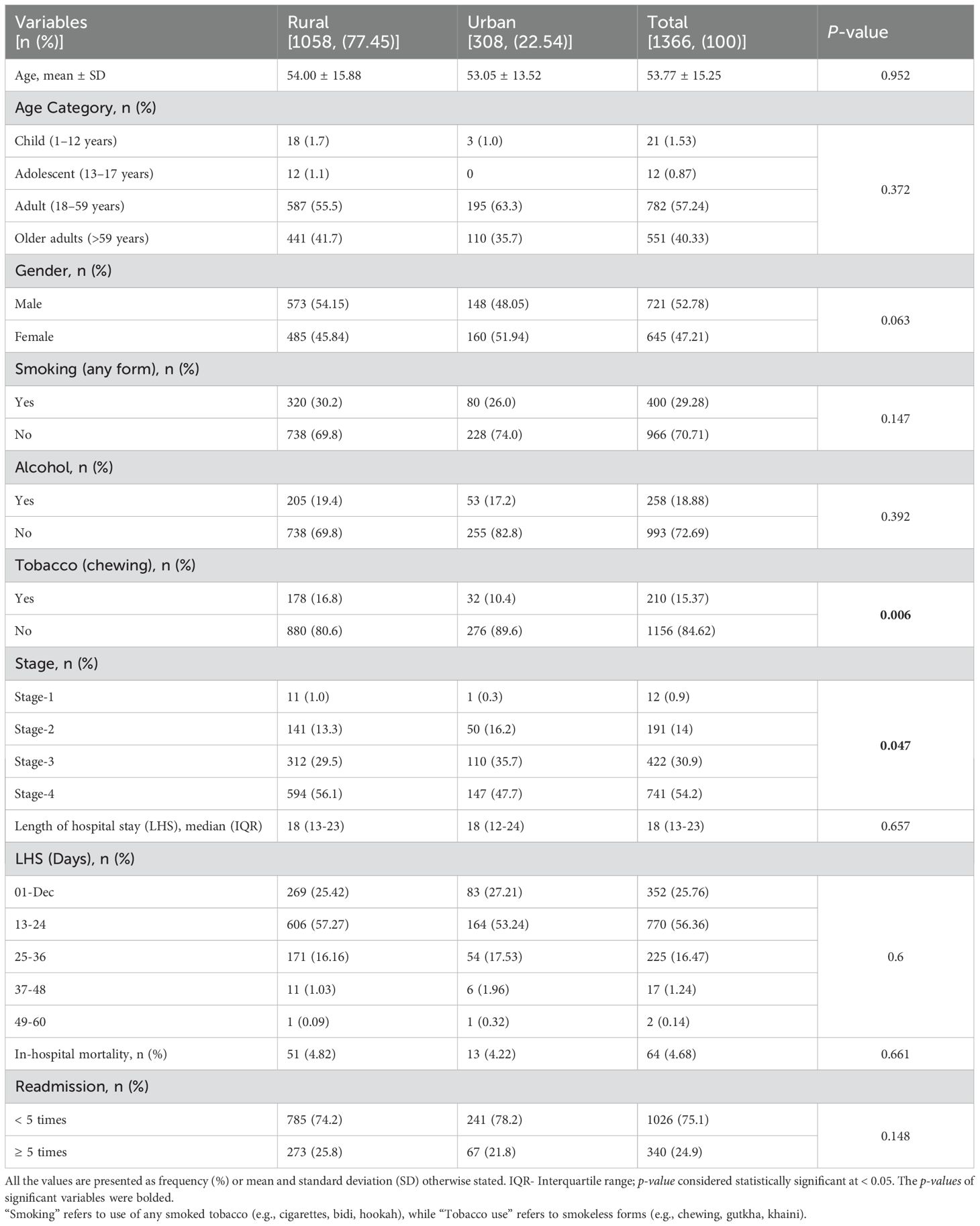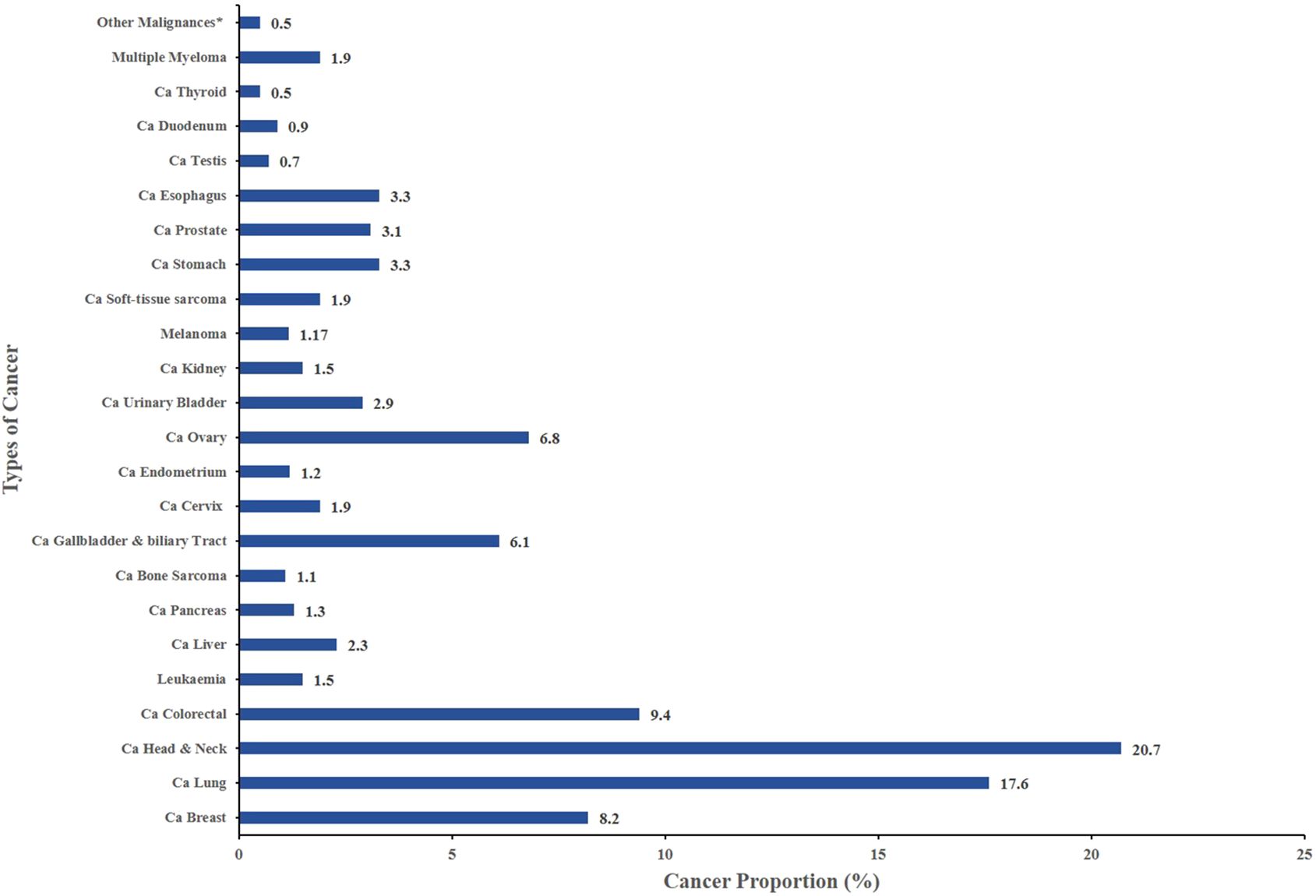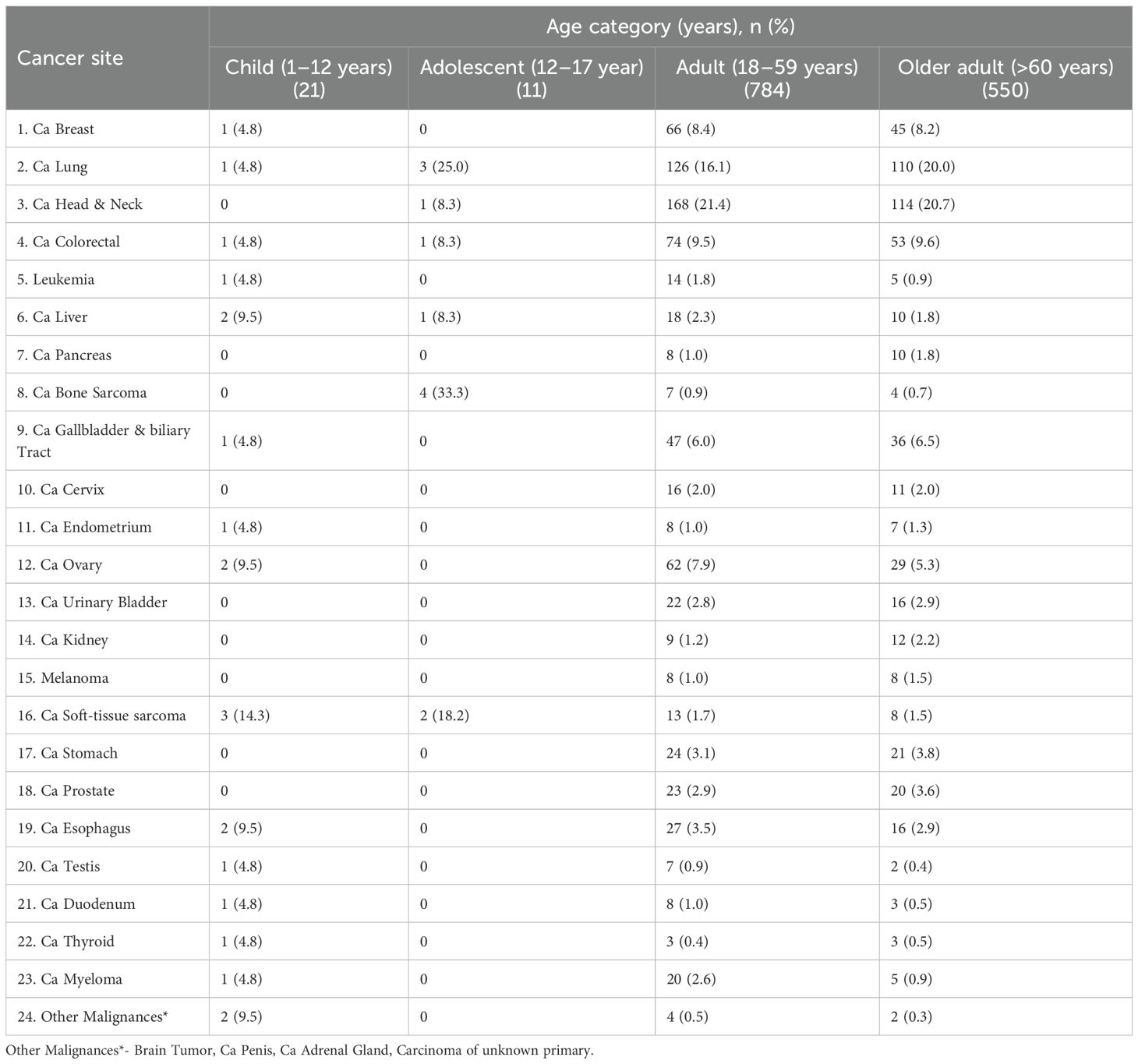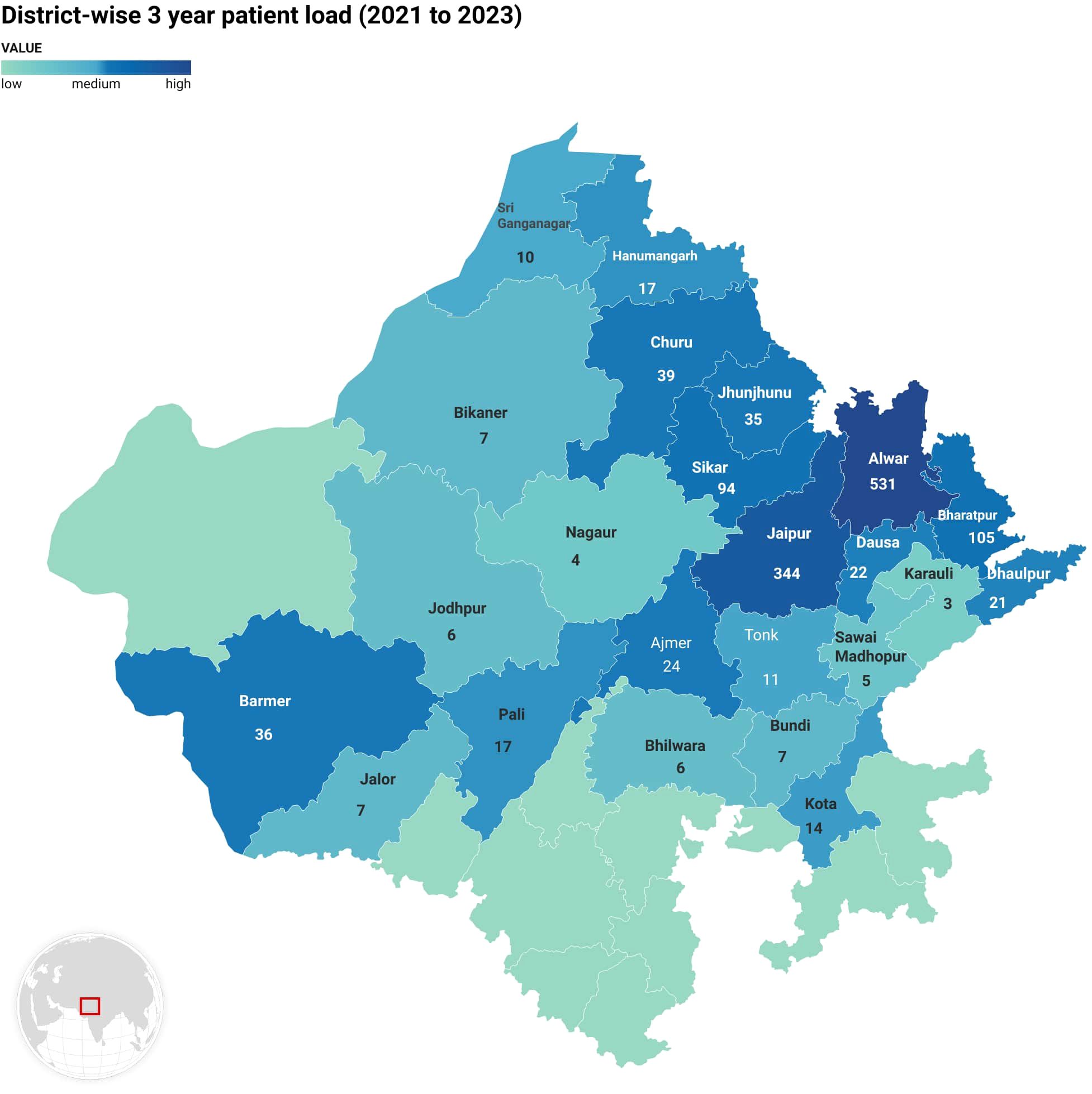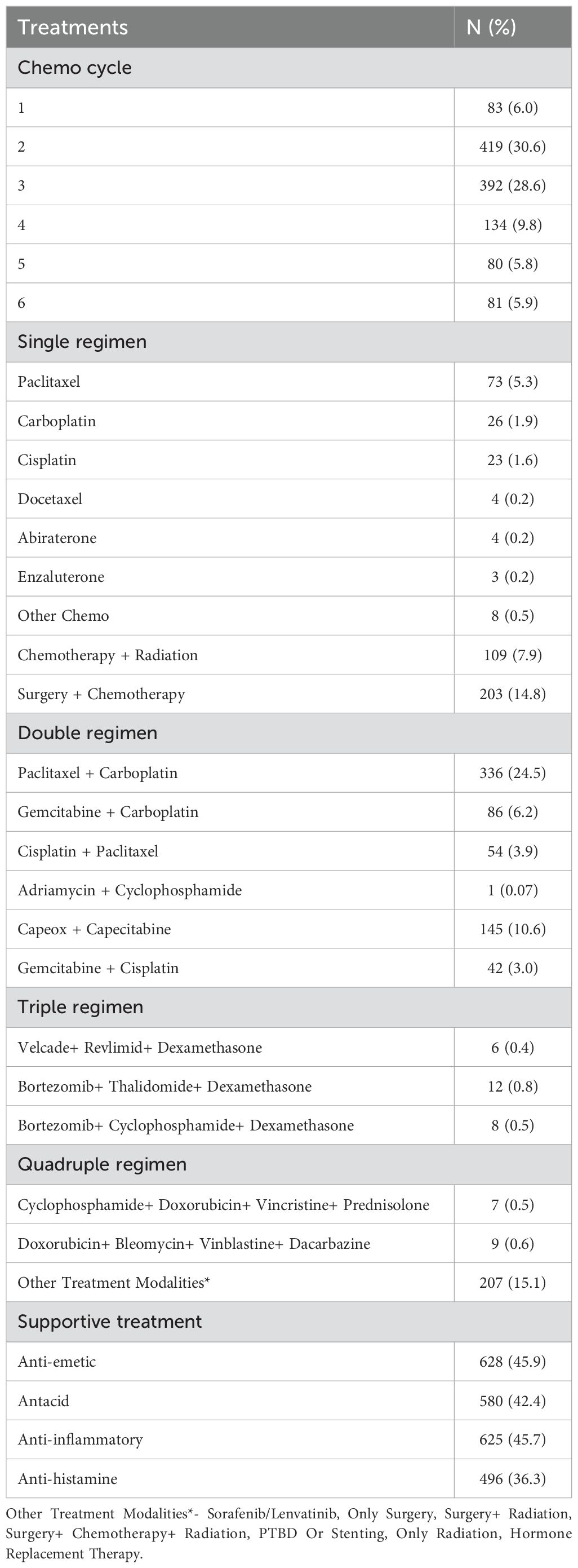- 1Department of Pharmacy Practice, National Institute of Medical Sciences and Research, Jaipur, Rajasthan, India
- 2Department of Oncology, National Institute of Medical Sciences and Research, Jaipur, Rajasthan, India
- 3Clinical Research Division, Patanjali Research Foundation, Trust, Haridwar, Uttarakhand, India
- 4Department of Management, NIMS Institute of Management and Commerce, NIMS University, Jaipur, Rajasthan, India
- 5Department of Endocrinology, National Institute of Medical Sciences and Research, Jaipur, Rajasthan, India
- 6Institute of Pediatric Gastroenterology and Hepatology, National Institute of Medical Sciences and Research, Jaipur, Rajasthan, India
Background: Cancer poses a growing public health challenge in India, with significant urban–rural disparities in diagnosis and treatment. This study aimed to evaluate the epidemiological profile and treatment patterns of cancer patients in Rajasthan, focusing on differences in disease presentation, treatment modalities, and outcomes between urban and rural populations.
Methods: A retrospective observational study was conducted at the National Institute of Medical Sciences and Research, Jaipur, including 1,366 histopathologically confirmed cancer patients admitted between January 2021 and December 2023. Data on demographics, cancer type, stage, treatment, and outcomes were analyzed using SPSS version 28, comparing rural and urban groups.
Results: Of the 1,366 patients, 77.45% were from rural areas. Rural patients had higher rates of advanced-stage (Stage IV) presentation (56.1% vs. 47.7%, p = 0.047) and tobacco use (16.8% vs. 10.4%, p = 0.006). Head and neck cancers were most common in men (20.7%), and breast cancer in women (8.2%). Chemotherapy was the predominant treatment (84%) modality, while urban patients more frequently received multimodal therapy. In-hospital mortality was comparable between groups (4.82% vs. 4.22%, p = 0.661), as were readmission rates.
Conclusion: Rural patients experienced a greater cancer burden due to delayed diagnosis and limited access to comprehensive care. Strengthening rural oncology services, improving early detection, and addressing modifiable risk factors like tobacco use are critical for reducing disparities and improving outcomes.
Introduction
Cancer remains one of the most formidable challenges to global health, representing a complex disease characterized by uncontrolled cell growth that leads to significant morbidity and mortality. In 2022 alone, approximately 20 million new cancer cases were diagnosed globally, with nearly 9.7 million deaths attributed to this devastating disease. Among the various types, lung cancer (12.4%) emerged as the most frequently diagnosed malignancy, followed by colorectal (9.6%), prostate (7.3%), and stomach cancers (4.9%) (1). Asia, home to nearly half the global population, bore the brunt of the cancer burden, accounting for 49.3% of global cases with an incidence rate of 169.1 per 100,000 in 2020 (2). While historically prevalent in developed nations, the incidence of cancer has seen a dramatic rise in developing countries in recent decades (3).
In India, the scenario is equally alarming. With over 1.32 million new cases and 0.85 million deaths reported in 2022, cancer is now the second leading cause of mortality in the country. The spectrum of cancers affecting the Indian population includes malignancies of the lung, breast, stomach, cervix, and esophagus, among others (4, 5). Striking geographical variations highlight the heterogeneity of cancer prevalence across the country, from the densely populated Ganges belt to the Deccan plains, and from urban centers to rural communities (6). Particularly concerning is Northeast India, where the incidence of cancers such as nasopharyngeal, esophageal, and cervical cancers is disproportionately high (7). Among women, breast cancer is the most prevalent, with an age-adjusted incidence rate of 25.8 per 100,000 and a mortality rate of 12.7 per 100,000 (8). In Rajasthan, the crude annual cancer incidence rose markedly from 58.8 to 72.6 per 100,000 people between 1990 and 2016, with breast cancer prevalence reaching as high as 98 per 100,000 in rural regions (9, 10).
In line with the study objective, this investigation specifically aims to explore the epidemiological distribution and urban–rural disparities among patients with malignant neoplasms in a tertiary care hospital in Rajasthan.
The rising cancer burden in India is driven by a complex interplay of genetic predisposition, environmental factors, and lifestyle choices (11). Beyond its profound health implications, cancer also imposes a significant economic burden, with high costs of diagnosis and treatment further exacerbating the challenges faced by patients and their families (12).
Understanding the epidemiological profile of cancer patients is crucial for formulating effective cancer control strategies. Comprehensive data on the types, distribution, and demographic patterns of malignancies can help guide early detection, screening programs, and prevention efforts tailored to specific regional needs. This study was therefore designed to identify patterns of healthcare utilization, stage at diagnosis, and treatment characteristics among urban and rural cancer patients, thereby addressing a major knowledge gap in regional cancer epidemiology.
Methodology
Study design and population
This study was conducted at the National Institute of Medical Sciences and Research (NIMS), a tertiary care hospital in Jaipur, Rajasthan. A total of 1826 case sheets from the surgical and medical oncology departments were retrospectively reviewed from medical records between January 2021 and December 2023. As this was a retrospective record-based study, all consecutive eligible cases within the defined period were included. No formal sample size calculation was performed. The selection and exclusion process of cases are illustrated in Figure 1.
Inclusion and exclusion criteria
Inclusion criteria were strictly defined to ensure data reliability and clinical relevance. Patients were included if they met all of the following conditions: confirmed histopathological or cytological diagnosis of invasive malignancy (excluding carcinoma in situ and borderline tumors); complete medical records including demographic details, clinical staging, diagnostic reports, and treatment documentation; primary cancer diagnosis and initiation of treatment at the participating hospital (to ensure consistency in staging and management protocols); no concurrent primary malignancy at the time of registration; and age ≥ 18 years at diagnosis (all adult age categories included).
Exclusion criteria were applied as follows: patients with unconfirmed cancer diagnosis, incomplete medical records, borderline tumors or intraepithelial neoplasia, those diagnosed outside Rajasthan but registered at NIMS only for follow-up, and patients with coexisting primary cancers were excluded.
After applying these criteria, 1366 patients from 23 districts of Rajasthan (Ajmer, Alwar, Barmer, Bharatpur, Bhilwara, Bikaner, Bundi, Churu, Dausa, Dhaulpur, Hanumangarh, Jaipur, Jalor, Jhunjhunu, Jodhpur, Karauli, Kota, Sawai Madhopur, Nagaur, Pali, Sikar, Shri Ganganagar, Tonk) were included in the final analysis.
Cancer classification
Cancer types were classified according to the International Classification of Diseases for Oncology, 3rd edition (ICD-10) of the World Health Organization (13). Demographic, clinical, diagnostic, and treatment data were retrieved from hospital records. Tumor staging was performed according to the American Joint Committee on Cancer (AJCC) 8th edition, using clinical staging information abstracted from patient medical records by trained research staff based on documentation by the treating oncologists at the time of diagnosis (14).
Lifestyle and behavioral variables
Information on smoking, alcohol consumption, and smokeless tobacco (chewing) was obtained from patient medical records as documented during hospital admission or outpatient evaluation. Smoking (any form) included the use of any smoked tobacco products such as cigarettes, bidis, or hookah, while tobacco (chewing) referred to smokeless forms such as gutkha, khaini, or betel quid with tobacco. Alcohol use referred to any reported consumption of alcoholic beverages. Only patients with current use of smoking, alcohol, or smokeless tobacco at the time of admission were coded as “Yes,” whereas those without current use were coded as “No”.
Data analysis
Socio-demographic and clinical characteristics were analyzed using descriptive statistics. Continuous variables were reported as mean ± standard deviation, and categorical variables as frequencies and percentages. Data were stratified by area of residence (rural vs. urban). Normality was assessed using the Shapiro-Wilk test. Group comparisons for continuous variables were performed using the independent Student’s t-test, and for categorical variables using the chi-square test. Statistical significance was set at p < 0.05. Multivariable binary logistic regression was performed to evaluate the independent association between residence status and stage at presentation. All analyses were conducted using Statistical Package for the Social Sciences (SPSS) version 28 software. Key findings were visualized using bar charts and pie charts created in Microsoft Excel for enhanced interpretability.
Results
Clinic-demographic characteristics
A total of 1366 patients were enrolled, of whom 1058 (77.45%) were from rural areas and 308 (22.54%) were from urban areas. The mean age was comparable between rural (54.00 ± 15.88 years) and urban (53.05 ± 13.52 years) patients. Age distribution across categories (children, adolescents, adults, and older adults) did not differ significantly between the groups (p = 0.372) (Table 1).
Gender distribution showed a slightly higher proportion of females in the urban cohort (51.94%) compared with the rural group (45.84%). The prevalence of smoking (29.28%), alcohol consumption (18.88%), and smokeless tobacco use (15.37%) was assessed, with tobacco chewing significantly higher among rural patients (16.8%) than urban patients (10.4%) (p = 0.006) (Table 1).
Disease staging showed a statistically significant difference (p = 0.047), with rural patients more frequently presenting at stage 4 (56.1%) compared with urban patients (47.7%). The median length of hospital stay was identical across both groups (18 days), with interquartile ranges showing minimal variation (rural: 13–23, urban: 12–24, p = 0.657). The majority of patients (56.36%) had hospital stays ranging from 13 to 24 days. Overall clinical characteristics and outcome measures are shown in Table 1.
Multivariable regression analysis
To account for potential confounding, a multivariable binary logistic regression analysis was performed to assess factors associated with late-stage cancer presentation, adjusting for age, sex, residence, tobacco use, and treatment modality. After controlling for these variables, rural residence remained significantly associated with late-stage presentation (AOR = 1.37, 95% CI: 1.06 to 1.78, p = 0.018) (Supplementary Table S1).
Distribution of cancer types
In our study cohort, the most commonly diagnosed cancers in men includes Head & Neck Cancer (20.7%), Lung Cancer (17.6%), Prostate Cancer (6.8%), Stomach Cancer (3.3%). In contrast, women predominantly present with breast cancer (8.2%), cervical cancer (6.8%), ovarian cancer (6.1%), Gallbladder & Biliary Tract Cancer (2.9%) reflecting the substantial impact of reproductive and hormonal factors on cancer epidemiology (Table 2; Figure 2).
Table 3 shows the distribution of cancer types across four age categories: children, adolescents, adults, and older adults. The majority of cancer cases occurred in adults (57.39%) and older adults (40.26%), with only a small proportion in children (1.57%) and adolescents (0.8%). The most common malignancies in adults and older adults were breast, lung, head and neck, and colorectal cancers. Pediatric and adolescent cancers were rare, with only isolated cases of leukemia, liver cancer, bone sarcoma, and soft-tissue sarcoma.
District-wise distribution
The highest number of cases were reported in Alwar (38.9%), followed by Jaipur (25.2%), Bharatpur (7.7%), Sikar (7.0%) of the cases, while other districts such as Jalor and Jodhpur, Sawai Madhopur, Karauli contributed smaller proportions (Figure 3).
Treatment modalities
Table 4 outlines how different treatment plans were used for 1,366 patients. Chemotherapy was the predominant treatment modality (84%), followed by surgery (14%), radiation therapy (1%), and other treatments (1%) (Figure 4). The lower proportion of radiation therapy cases is attributed to the recent establishment of the Radiation Oncology Department in late October 2023, with data reviewed up to December 2023.
Among patients receiving chemotherapy, the majority completed two cycles (30.67%), followed by three cycles (28.69%). Regarding single-drug regimens, Paclitaxel and Carboplatin were the most frequently prescribed agents. For two-drug combinations, Paclitaxel with Carboplatin was the most common pairing, followed by CapeOX (Capecitabine and Oxaliplatin). More complex regimens involving three or four drugs were less frequent, including combinations such as Bortezomib, Thalidomide, and Dexamethasone, or Doxorubicin, Bleomycin, Vinblastine, and Dacarbazine. In addition to chemotherapy, approximately 15% of patients received other forms of therapy such as targeted therapy, surgery, or multimodal combinations.
Supportive therapies
Anti-emetics (45.97%), anti-inflammatory drugs (45.75%), antacids (42.45%), and antihistamines (36.31%) were the most commonly administered supportive therapies (Table 4). These therapies were integral to improving patient quality of life during treatment.
Mortality and outcomes
In-hospital mortality was similar between rural (4.82%) and urban (4.22%) groups (p = 0.661). Readmission rates were also not significantly different, with 75.1% of patients readmitted fewer than five times (p = 0.148) (Table 1).
Trend analysis of year-wise cancer distribution (2021–2023)
Supplementary Table S2 depict a clear upward trend in cancer incidence, rising from 140 cases in 2021 to 710 in 2023. Head and neck cancers consistently remained the most prevalent, while lung and breast cancers showed a sharp increase over the three years. Colorectal cancers also maintained a high frequency, whereas gallbladder and gynecological cancers showed a gradual decline. Notably, emerging cases of pancreatic, prostate, myeloma, and soft-tissue sarcomas in 2023 may reflect advancements in diagnostic capabilities. Overall, the data indicate a growing burden of thoracic and gastrointestinal malignancies in recent years.
Discussion
To our knowledge, this is the first study to provide a snapshot regarding the urban-rural disparity and determine the healthcare utilization among cancer patients in Rajasthan. This study presents a detailed comparative analysis of the clinicodemographic characteristics of rural and urban patients, with a focus on identifying patterns of healthcare utilization, disease presentation, and treatment outcomes.
The predominance of rural patients in the study population reflects the geographic distribution and catchment area of the healthcare facility under investigation. Interestingly, these findings contrast with global patterns and earlier studies reporting a higher cancer burden in urban areas (15, 16). More recent evidence from the United States, however, has demonstrated higher overall cancer incidence among rural populations compared with urban counterparts, particularly for tobacco and infection associated malignancies, highlighting that rural and urban disparities in cancer burden persist even in developed settings (17). In India, similar trends have been observed, with rural populations, particularly in eastern states such as West Bengal and Bihar and northern states such as Uttar Pradesh and Rajasthan, showing higher rates of late-stage cancer presentation (18). Recent hospital and population-based cancer registry reports from Bihar and Uttar Pradesh further support this pattern, documenting a rising cancer burden in rural areas and a greater prevalence of advanced stage and site-specific cancers, particularly cervical malignancies among rural women (19, 20).
Consistent with these findings, several studies from India, China, and the United States highlight persistent disparities in rural cancer care, characterized by limited healthcare infrastructure, delayed diagnosis, and restricted access to specialized oncology services (21–23). These discrepancies likely stem from healthcare inaccessibility, socioeconomic constraints, and lower educational attainment, all of which contribute to diagnostic delays and a disproportionate cancer burden in rural communities.
According to the demographic statistics, the majority of the study population hailed from rural areas, with 54.15% of the cancer patients being male and 45.84% being female. This gender distribution is consistent with global cancer data, which show that certain cancer forms are more common among men (24). The average age of the patients was 53.78 years, indicating that cancer cases were predominant among the older population, which is consistent with the general pattern that shows an increase in cancer incidence with age (25, 26).
Tobacco use was significantly more prevalent among rural patients (16.8%) compared to their urban counterparts (10.4%) (p = 0.006). This pattern aligns with nationwide data from the Global Adult Tobacco Survey (GATS-2, 2017), which reported higher smokeless tobacco use in rural India, and is consistent with prior research, including Gayatri, et al. (2023), which highlighted the entrenched cultural acceptability of tobacco in rural settings, especially among males, compounded by poor health literacy and limited access to cessation services (27, 28). The public health implications are far-reaching, necessitating culturally sensitive, locally adapted tobacco control interventions that integrate behavioral change, policy enforcement, and health education.
One of the most clinically significant findings of this study was the advanced stage of disease at presentation among rural patients. A considerably higher proportion of rural patients (56.1%) presented with Stage 4 disease compared to 47.7% of urban patients (p = 0.047). This pattern aligns with a population-based registry study from Varanasi district (Uttar Pradesh, North India) (15), which reported that rural cancer patients were more likely to be diagnosed at distant stage than their urban counterparts. It is also consistent with a systematic review by Afshar et al., which found that late-stage diagnosis is more common among rural patients due to delays in seeking medical care and limited access to diagnostic facilities (29). The importance of early detection in improving cancer prognosis is underscored by the high prevalence of late-stage diagnosis in rural areas, which highlights the urgent need for improved screening and awareness programs in these regions. In the adjusted analysis, rural residence remained significantly associated with late-stage presentation, indicating that this disparity persisted even after controlling for age, sex, tobacco use, and treatment modality.
Economic burden significantly exacerbates rural-urban disparities in cancer care. Nationally, cancer treatment pushes 55–65% of households into poverty, with rural families incurring 1.8-times higher catastrophic costs due to drugs, travel, and lost income (30). In Rajasthan, the Mukhya Mantri Nishulk Dava Yojana (Free Cancer Medicine Scheme) addresses this burden by supplying 39 essential chemotherapy drugs free of cost through public hospitals, substantially lowering patients’ out-of-pocket expenses. Despite this, urban patients in our study received more combination regimens, likely due to uncovered radiotherapy and travel expenses. Integrating free diagnostics, tele-oncology, and Ayushman Bharat–Chiranjeevi Yojana coverage is essential to eliminate economic barriers and improve equitable outcomes.
Readmission rates also did not differ significantly between the two groups, though rural population had slightly higher readmission rate (>5 times). A finding by Echere et al. (2024), demonstrated a higher frequency of readmissions in rural patients due to limited healthcare access, higher prevalence of chronic conditions, and socioeconomic challenges (31). In the current study setting, the presence of a structured follow-up mechanism, potentially supported by digital health initiatives and community health workers have mitigated this disparity. This highlights the importance of robust discharge planning and patient follow-up to ensure treatment adherence and reduce preventable readmissions, especially in resource-limited rural settings.
The district-wise analysis revealed that Alwar had the highest number of cases, followed by Jaipur, Bharatpur, and Sikar. The distribution of cancers and the number of cases in these districts represent the regional cancer burden. A study by Freddie et al. highlights the significance of district-level cancer registries for successful healthcare planning (32).
There was a notable difference in the distribution of treatment regimens among patients living in rural and urban areas. A wide range of chemotherapy combinations, with carboplatin and paclitaxel being the most common double regimen treatment. The use of single, double, triple, and quadruple chemotherapy regimens is consistent with current cancer treatment guidelines, which frequently include combination medicines to increase efficacy (33). In our study, patients living in urban areas tended to receive a combination of therapies, such as chemotherapy and radiation, while those in rural areas predominantly received single-regimen treatments. This disparity can be attributed to differences in healthcare infrastructure and availability of specialized oncology services. A study by Bhatia S et al. highlighted the challenges faced by patients in rural areas when it comes to accessing advanced cancer treatments. As a result, these patients often experience less favorable outcomes (23). Supportive therapy was frequently used, with anti-emetic, anti-inflammatory, and antacid drugs being the most popular. The widespread use of supportive therapy emphasizes the necessity of controlling cancer treatment side effects to improve patient quality of life (34).
The in-hospital mortality rate was higher among patients from rural areas (4.82%) compared to those from urban areas (4.22%). This is consistent with the results of a study conducted by Blake KD et al. (2017) and Afshar N et al. (2019) revealed that rural cancer patients experienced higher mortality rates (29, 35). The study by Tedder T et al. (2017) further reinforces these findings, emphasizing that patients in rural areas frequently exhibit more advanced disease and face challenges in accessing palliative care services (36).
Limitations
This study is not without limitations. First, it was a single-center retrospective analysis, which may limit the generalizability of findings to the broader population of Rajasthan. Second, missing or incomplete documentation in retrospective data could have introduced minor classification bias. Third, the predominance of rural participants and the hospital’s tertiary-care referral pattern may have introduced selection and referral bias, leading to overrepresentation of certain geographic regions. Despite inclusion of a large cohort from multiple districts, these factors could have influenced the observed urban–rural distribution. Future multicentric, population-based registries with prospective follow-up are warranted to validate and expand these observations.
Conclusion
This study provides a comprehensive epidemiological assessment of cancer patients from a tertiary care center in Rajasthan, revealing marked urban–rural disparities in disease stage, healthcare access, and treatment patterns. The predominance of rural patients, late-stage presentation, and higher tobacco use reflect critical gaps in early detection and preventive care. Targeted interventions such as deployment of mobile cancer screening units, district-level oncology clinics, and community-based tobacco cessation and awareness programs are urgently needed. Strengthening regional cancer registries and tele-oncology networks can further enhance early diagnosis and continuity of care in underserved areas. These findings underscore the need for evidence-driven policy measures to promote equitable access and improved cancer outcomes across diverse populations.
Data availability statement
The raw data supporting the conclusions of this article will be made available by the authors upon genuine request to the corresponding authors, without undue reservation.
Ethics statement
The study was approved by the Institutional Ethics Committee, NIMS University (Approval No. NIMSUR/IEC/2023/687). It was a retrospective record-based analysis conducted in accordance with institutional and national ethical guidelines. Because the study did not involve direct interaction with patients and utilized anonymized data, the requirement for written informed consent was waived in accordance with national legislation and institutional policy.
Author contributions
SD: Writing – review & editing, Writing – original draft, Conceptualization. PP: Conceptualization, Data curation, Writing – original draft. AS: Formal analysis, Writing – review & editing. SM: Software, Writing – review & editing. SR: Writing – review & editing, Methodology. MG: Writing – review & editing, Investigation, Validation. PN: Validation, Writing – review & editing. SK: Software, Writing – review & editing. RS: Formal analysis, Writing – review & editing. GS: Formal analysis, Writing – review & editing. MS: Methodology, Writing – review & editing. DN: Supervision, Writing – review & editing. BT: Writing – review & editing, Project administration.
Funding
The author(s) declared that financial support was not received for this work and/or its publication.
Acknowledgments
We sincerely thank the administration of NIMS University for their timely and efficient support, which was instrumental in facilitating this study. We also extend our heartfelt appreciation to the medical record department for their invaluable assistance in data retrieval and organization. Furthermore, we are deeply grateful to the Department of Oncology for their unwavering support and collaboration throughout the course of this research.
Conflict of interest
The authors declare that the research was conducted in the absence of any commercial or financial relationships that could be construed as a potential conflict of interest.
Generative AI statement
The author(s) declare that no Generative AI was used in the creation of this manuscript.
Any alternative text (alt text) provided alongside figures in this article has been generated by Frontiers with the support of artificial intelligence and reasonable efforts have been made to ensure accuracy, including review by the authors wherever possible. If you identify any issues, please contact us.
Publisher’s note
All claims expressed in this article are solely those of the authors and do not necessarily represent those of their affiliated organizations, or those of the publisher, the editors and the reviewers. Any product that may be evaluated in this article, or claim that may be made by its manufacturer, is not guaranteed or endorsed by the publisher.
Supplementary material
The Supplementary Material for this article can be found online at: https://www.frontiersin.org/articles/10.3389/fonc.2025.1636807/full#supplementary-material
References
1. Bray F, Laversanne M, Sung H, Ferlay J, Siegel RL, Soerjomataram I, et al. Global cancer statistics 2022: GLOBOCAN estimates of incidence and mortality worldwide for 36 cancers in 185 countries. CA: Cancer J Clin. (2024) 74:229–63. doi: 10.3322/caac.21834
2. Huang J, Ngai CH, Deng Y, Tin MS, Lok V, Zhang L, et al. Cancer incidence and mortality in Asian countries: a trend analysis. Cancer Control. (2022) 29:10732748221095955. doi: 10.1177/10732748221095955
3. Rajpal S, Kumar A, and Joe W. Economic burden of cancer in India: Evidence from cross-sectional nationally representative household survey, 2014. PloS One. (2018) 13:e0193320. doi: 10.1371/journal.pone.0193320
4. Shafi L, Iqbal P, and Khaliq R. Cancer burden in India: A statistical analysis on incidence rates. Indian J Public Health. (2023) 67:582–7. doi: 10.4103/ijph.ijph_1587_22
5. Gao P, Chen J, Hong Z, Choi M, Morgan A, Petushkov A, et al. Landscape of cancer clinical trials in India–a comprehensive analysis of the Clinical Trial Registry-India. Lancet Regional Health-Southeast Asia. (2024) 24. doi: 10.1016/j.lansea.2023.100323
6. Sirohi B and Mathew A. Patterns of cancer incidence in India–What next? Cancer Research Statistics Treat. (2020) 3:790–2. doi: 10.4103/crst.crst_35_21
7. Mathur P, Sathishkumar K, Chaturvedi M, Das P, Sudarshan KL, Santhappan S, et al. Cancer statistics, 2020: report from national cancer registry programme, India. JCO Global Oncol. (2020) 6:1063–75. doi: 10.1200/GO.20.00122
8. Malvia S, Bagadi SA, Dubey US, and Saxena S. Epidemiology of breast cancer in Indian women. Asia-Pacific J Clin Oncol. (2017) 13:289–95. doi: 10.1111/ajco.12661
9. Singh G and Raghav P. 1047 epidemiology of different cancers in rural jodhpur (India). Int J Epidemiol. (2021) 50:dyab168–617. doi: 10.1093/ije/dyab168.617
10. Singh R, Kumar S, Nakash P, Kumar R, Kumar G, Pal P, et al. Prevalence of breast cancer in rural population of Jaipur: a survey-based observational study. Sci Rep. (2024) 14:8865. doi: 10.1038/s41598-024-58717-0
11. Rahman MS, Suresh S, and Waly MI. Risk factors for cancer: Genetic and environment. Bioactive Components Diet Med Treat Cancer Prev. (2018), 1–23. doi: 10.1007/978-3-319-75693-6_1
12. Hacker K. The burden of chronic disease. Mayo Clinic Proceedings: Innovations Qual Outcomes. (2024) 8:112–9. doi: 10.1016/j.mayocpiqo.2023.08.005
13. Edition T. International classification of diseases for oncology. Geneva: World Health Organization (2020).
14. Zhu H and Doğan BE. American Joint committee on cancer’s staging system for breast cancer: summary for clinicians. Eur J Breast Health. (2021) 17:234. doi: 10.4274/ejbh.galenos.2021.2021-4-3
15. Khanna D, Sharma P, Budukh A, Vishwakarma R, Sharma AN, Bagal S, et al. Rural-urban disparity in cancer burden and care: findings from an Indian cancer registry. BMC cancer. (2024) 24:308. doi: 10.1186/s12885-024-12041-y
16. Li X, Deng Y, Tang W, Sun Q, Chen Y, Yang C, et al. Urban-rural disparity in cancer incidence, mortality, and survivals in Shanghai, China, during 2002 and 2015. Front Oncol. (2018) 8:579. doi: 10.3389/fonc.2018.00579
17. Semprini J, Gadag K, Williams G, Muldrow A, and Zahnd WE. Rural–urban cancer incidence and trends in the United States, 2000 to 2019. Cancer epidemiol Biomarkers Prev. (2024) 33:1012–22. doi: 10.1158/1055-9965.EPI-24-0072
18. Sahu DP, Subba SH, and Giri PP. Cancer Awareness and its Predictors among the Rural Population of Eastern India: A Cross-sectional Study. Indian J Community Med. (2025) 50:324–30. doi: 10.4103/ijcm.ijcm_195_23
19. Pandey A, Raj S, Madhawi R, Devi S, and Singh RK. Cancer trends in Eastern India: Retrospective hospital-based cancer registry data analysis. South Asian J Cancer. (2019) 8:215–7. doi: 10.4103/sajc.sajc_321_18
20. Budukh AM, Pradhan S, Singh VB, Khanna D, Bagal SS, Chakravarti PS, et al. Cancer pattern in Varanasi district from Uttar Pradesh state of India, a foundation for cancer control based on the first report of the population-based cancer registry. Indian J Cancer. (2024) 61:383–9. doi: 10.4103/ijc.IJC_44_21
21. Sathwara JA, Balasubramaniam G, Bobdey SC, Jain A, and Saoba S. Sociodemographic factors and late-stage diagnosis of breast cancer in India: A hospital-based study. Indian J Med Paediatric Oncol. (2017) 38:277–81. doi: 10.4103/ijmpo.ijmpo_15_16
22. Wang H, Hua X, Yao N, Zhang N, Wang J, Anderson R, et al. The urban-rural disparities and associated factors of health care utilization among cancer patients in China. Front Public Health. (2022) 10:842837. doi: 10.3389/fpubh.2022.842837
23. Bhatia S, Landier W, Paskett ED, Peters KB, Merrill JK, Phillips J, et al. Rural–urban disparities in cancer outcomes: opportunities for future research. JNCI: J Natl Cancer Institute. (2022) 114:940–52. doi: 10.1093/jnci/djac030
24. Ward EM, Sherman RL, Henley SJ, Jemal A, Siegel DA, Feuer EJ, et al. Annual report to the nation on the status of cancer, featuring cancer in men and women age 20–49 years. JNCI: J Natl Cancer Institute. (2019) 111:1279–97. doi: 10.1093/jnci/djz106
25. Risk factors: age (2021). Cancer.gov. Available online at: https://www.cancer.gov/about-cancer/causes-prevention/risk/age (Accessed January 10, 2025).
26. Ju W, Zheng R, Wang S, Zhang S, Zeng H, Chen R, et al. The occurrence of cancer in ageing populations at global and regional levels, 1990 to 2019. Age Ageing. (2023) 52:afad043. doi: 10.1093/ageing/afad043
27. Verma M, Rana K, Bhatt G, Sharma N, and Lal P. Trends and determinants of tobacco use initiation in India: analysis of two rounds of the Global Adult Tobacco Survey. BMJ Open. (2023) 13:e074389. doi: 10.1136/bmjopen-2023-074389
28. Nayak G, Kavitha AK, Satpathy N, Mohapatra I, Epari V, Kishore J, et al. Gendered pattern and predictors of tobacco use in India: evidence from the second round of Global Adult Tobacco Survey. Indian J Community Med. (2023) 48:241–9. doi: 10.4103/ijcm.ijcm_102_22
29. Afshar N, English DR, and Milne RL. Rural–urban residence and cancer survival in high-income countries: a systematic review. Cancer. (2019) 125:2172–84. doi: 10.1002/cncr.32073
30. Prinja S, Dixit J, Gupta N, Dhankhar A, Kataki AC, Roy PS, et al. Financial toxicity of cancer treatment in India: towards closing the cancer care gap. Front Public Health. (2023) 11:1065737. doi: 10.3389/fpubh.2023.1065737
31. Echere J, Okobi OE, Iyun OB, Gyampoh GK, and Gill SK. Health disparities in hospital readmissions in rural vs urban populations in the United States: A comprehensive review of factors and reduction strategies. Med Res Arch. (2024) 12. doi: 10.18103/mra.v12i7.5699
32. Bray F, Parkin DM, Gnangnon F, Tshisimogo G, Peko JF, Adoubi I, et al. Cancer in sub-Saharan Africa in 2020: a review of current estimates of the national burden, data gaps, and future needs. Lancet Oncol. (2022) 23:719–28. doi: 10.1016/S1470-2045(22)00270-4
33. Mokhtari RB, Homayouni TS, Baluch N, Morgatskaya E, Kumar S, Das B, et al. Combination therapy in combating cancer. Oncotarget. (2017) 8:38022. doi: 10.18632/oncotarget.16723
34. Suhayono S, Wibowo SA, Purnamasari I, Sukartini T, and Wabula LR. A systematic review of supportive therapy effect on quality of life in cancer patients. Jurnal Ners. (2020) 15:197–207. doi: 10.20473/jn.v15i1Sp.19013
35. Blake KD, Moss JL, Gaysynsky A, Srinivasan S, and Croyle RT. Making the case for investment in rural cancer control: an analysis of rural cancer incidence, mortality, and funding trends. Cancer Epidemiol Biomarkers Prev. (2017) 26:992–7. doi: 10.1158/1055-9965.EPI-17-0092
Keywords: cancer epidemiology, rural-urban disparities, treatment access, tobacco use, oncology outcomes, Rajasthan
Citation: Debnath S, Pal P, Singh AK, Mishra S, Rajotiya S, Ghosh M, Nakash P, Kumar S, Singh R, Sharma G, Singh M, Nathiya D and Tomar BS (2025) Epidemiological profile of patients with malignant neoplasm admitted to a tertiary care center in India: a retrospective cross-sectional study. Front. Oncol. 15:1636807. doi: 10.3389/fonc.2025.1636807
Received: 06 June 2025; Accepted: 19 November 2025; Revised: 14 November 2025;
Published: 08 December 2025.
Edited by:
Ruchi Roy, University of Illinois Chicago, United StatesReviewed by:
Senthil Kumar Nachimuthu, Mizoram University, IndiaJeffrey Mathew Boby, Government Medical College, Kozhikode, India
Akash Nagar, Dr. D. Y. Patil Medical College, Hospital and Research Centre, India
Copyright © 2025 Debnath, Pal, Singh, Mishra, Rajotiya, Ghosh, Nakash, Kumar, Singh, Sharma, Singh, Nathiya and Tomar. This is an open-access article distributed under the terms of the Creative Commons Attribution License (CC BY). The use, distribution or reproduction in other forums is permitted, provided the original author(s) and the copyright owner(s) are credited and that the original publication in this journal is cited, in accordance with accepted academic practice. No use, distribution or reproduction is permitted which does not comply with these terms.
*Correspondence: Pusparghya Pal, cHVzcGFyZ2h5YTAwNEBnbWFpbC5jb20=; Anurag Kumar Singh, YW51cmFna3JzaW5naDA2QGdtYWlsLmNvbQ==; Govind Sharma, Y21hZ292aW5kc2hhcm1hQGdtYWlsLmNvbQ==
 Sourav Debnath
Sourav Debnath Pusparghya Pal
Pusparghya Pal Anurag Kumar Singh
Anurag Kumar Singh Shivang Mishra
Shivang Mishra Sumit Rajotiya
Sumit Rajotiya Manashi Ghosh2
Manashi Ghosh2 Sachin Kumar
Sachin Kumar Roshni Singh
Roshni Singh Mahaveer Singh
Mahaveer Singh Deepak Nathiya
Deepak Nathiya